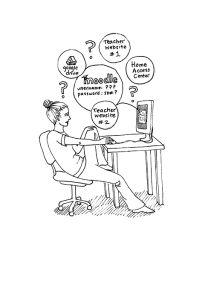When I was about 10 years old, I clearly remember peering under the counter to watch my babysitters flip through their multi-hundred-page textbooks and thick binders full of handouts. At such a young age, I was confused as to how one could be organized and take seven totally different classes.
One babysitter in particular gave me a “tutorial” on being organized in high school. He showed me the unit outlines for each class, the index of each textbook, and, most importantly, the glossy planner, where each assignment was clearly written out in a designated square. This concept of organization was so intriguing to me that when I started high school, I was excited to finally get my own textbooks and planner.
However, back when I was little, I didn’t realize that the world was slowly changing into a paperless and technological society. This change was familiar to me outside of school, but in school, I was always used to writing in cursive and reading printed books.
Freshman year, I was given three textbooks from which I did daily homework, and I wrote all of my assignments in my paper planner, just like my babysitters had done. Most of my classes were held in their designated areas, not in the computer lab, and school was the same familiar space it had always been.

When sophomore year hit, so did the “big boom” of technology, at least for me. Teachers in previous years may have been experimenting with websites, but I had never really been in a class with such high technological demands before. It was almost a necessity to have a smartphone and most of my teachers created their own websites, even P.E. teachers!
Each teacher creatively thought of a different program that “fit their needs more efficiently.” I quickly lost track of which password went to which site or which subject corresponded with each URL as I scrolled through Edmodo, Moodle, Google Drive, and other personal teacher websites. My brain was twisted as all the passwords mushed together in my head, and I had trouble accomplishing the actual assignments in a reasonable amount of time.
Mental chaos ensued as I began flipping through different websites to find homework, check answers, or watch “vodcasts.” This was a difficult task that wasted a lot of precious time that could have been spent on my actual homework.
Instead of using textbooks and paper outlines, I had to adjust to a new style of online learning that did not suit me at first. This year, my AP Economics class is my only one that uses a written unit outline. While the class also has an Edmodo page, the disorganization level is cut in half because I can rely mainly on the paper outline.
I propose that teachers provide both options — a website and a continuous cycle of paper outlines in order to eliminate confusion. I understand it is hard for the teachers to do this, but it allows students to work much more efficiently.
In addition, teachers should agree on one website to use, such as Edmodo. Instead of having a separate set of username and passwords for each website, students could find their assignments on one central website.
If teachers were to collaborate, our work as students would be much easier. Most of the websites that teachers use have overlapping features, and there is not necessarily a reason to use one website over another. The choice of which website to use may seem inconsequential for teachers, but it can have large impacts on a student’s ability to stay organized.
I am not saying that all technology is bad. There are benefits that can come out of using technology in the classroom, such as the embedding of podcast and video links, online editing on Google Drive to save paper, and greater research opportunities through online search engines.
The role of technology in school is changing, but that doesn’t mean books and unit outlines need to be eliminated. Teachers should coordinate websites and pass out paper outlines as well to please both technological and traditional learners.






